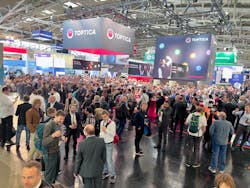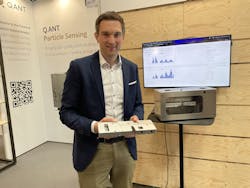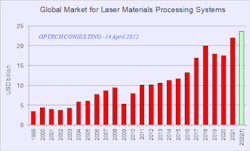On the first day of the trade fair, I had an emotional moment when I shook hands with Anke Odouli, exhibition director of the LASER World of PHOTONICS in Munich. Last year, we worked closely on the online event, Laser Industry Days 2021, but never met in person. This time, we greeted each other happily: “Finally, we made it!”
This was a feeling shared by many attendees and exhibitors this year. After more than two years without face-to-face meetings, it feels great to get in touch again. Perhaps this is also a reason why the booth parties surpassed everything known from recent years.
The attendance numbers were nothing to celebrate, because the trade show shrank to about 900 exhibitors, down from a record of 1325 in 2019. LASER World of PHOTONICS (known commonly as Laser Munich) published visitor numbers of 15,000 on Friday afternoon. “Ich bin zufrieden,” (I am satisfied) says Dr. Reinhard Pfeiffer, deputy CEO of Messe München.
Most Asian visitors were missing (kudos to the Chinese exhibitors who made it to Munich!), and there was no scientific congress aside. Nevertheless, the atmosphere was great, with people I spoke to counting about 70% of the leads they had in 2019. The congress will be back in June 2023 and, hopefully, the Asian guests too. The LASER World of PHOTONICS China 2022 was postponed to July 13-15. Visitors in Munich are wondering if it remains feasible.
Quantum: ‘A solution seeking a problem?’
Sixty-eight exhibitors united for the “World of Quantum.” In the center of the hall, people gathered around the picturesque mockup of IBM’s quantum computer. The company’s Heike Riehl chaired an impressive list of talks and discussion on the stage nearby.
The question puzzling most visitors was obvious: Is it a real opportunity or just hype? Peter Leibinger, CTO of the Trumpf Group, compared it with the start of the Laser Trade Fair in 1973. Nobody believed in photonics as a market then. Messe München bet on a new technology to grow: “The world as we know it today would not exist without photonics,” says Leibinger, “The world in 20 years will be different without quantum technology.”
Fortunately, real quantum products were on display at the World of Quantum. Michael Förtsch, CEO of Q.ANT, a startup owned by Trumpf, showed me a particle sensor they developed. Within a flow of small particles, this detector records velocity, direction, and size distribution. The quantum-extra is it also recognizes the shape of the tiny pieces.“It can be used to determine the flowability of powders,” says Förtsch. “This works with washing powder or coffee, where the sensor replaces manual testing.” Most importantly, it’s not a laboratory setup with dozens of mirrors. It’s a rugged metal case, with obvious roots in a mechanical engineering company.
30 kW: the new trend for cutting
While quantum dominated the event’s optics, cutting and welding are where the laser industry earns its profits. And there is the old trend of “bigger is better.” What about 30 kW fiber lasers for cutting? Is it just a niche? Many think so, but they may be wrong.Martino Burlamacchi, chairman of the Chinese Pentalaser Group, presented his experiences with such machines at the International Laser Marketplace. Pentalaser, which is owned by the Italian El.En group, sold 250 cutting systems with 20 to 30 kW in 2021. This year, they expect a 100% increase to 500 systems.
Big cutting systems are used to build construction machinery, such as excavators, or in shipyards. Why? They’re cheaper and faster than the established plasma cutters. China consumes 500 million tons of steel each year—50 million tons of it goes to shipyards. One such laser cutter processes about 10,000 tons, says Burlamacchi. They are two to three times faster than plasma cutters, save 300 tons of material each, and 340 MWh per machine per year. It drops costs by about 70% per part.
Several multikilowatt laser sources plus respective processing heads were shown in Munich, and I saw a 30 kW laser head at Scansonic with automatic focus shift correction. This is a crucial feature, since the focus shift at these powers must be corrected continuously. Still, it remains to be seen who will be able to survive the price competition within the Chinese market, where domestic systems are roughly 30% cheaper than imported machines.
Blue, green, and red
Of course, there were many things to see in Munich. Laser systems for e-car and battery production are certainly a big trend. Laserline celebrated a 3 kW blue laser (good for copper), and many bigger laser system providers showed off laser heads with which you can wobble, tune, or squeeze the beam profile as needed.
Last, but not least, is space technology. While Coherent presented a mirror segment of NASA’s Webb telescope as a showstopper, it was the Fraunhofer Society that showed a number of lasers to look down—or up to the sky—with lidar. Fraunhofer ILT presented a 3D-printed lidar system with a diode-pumped alexandrite laser inside, which they say is the most compact atmospheric lidar system. Researchers from the Leibniz Institute of Atmospheric Physics will deploy a group of these cubes to study winds at up to 100 km height and beyond.
Outlook: Mostly sunny
LASER World of PHOTONICS will return on June 27-30, 2023, probably with the regular Biergarten weather, and with the biggest European photonics congress, and lots more visitors from all around the world.

Andreas Thoss | Contributing Editor, Germany
Andreas Thoss is the Managing Director of THOSS Media (Berlin) and has many years of experience in photonics-related research, publishing, marketing, and public relations. He worked with John Wiley & Sons until 2010, when he founded THOSS Media. In 2012, he founded the scientific journal Advanced Optical Technologies. His university research focused on ultrashort and ultra-intense laser pulses, and he holds several patents.


